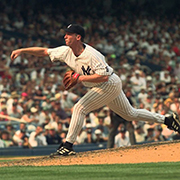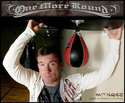|
It really depends on how often you practice. Further additional work doing HIIT, weight lifting and limited O-lifting will greatly benefit any martial artist once they got the basics of their chosen art under control. It's also very time-efficient way of working out, one of the reasons I never really got good at cycling. A heavy squat/deadlift session will be done in under 30 minutes. Add another 30 mins of accessories and you'll be cooked. HIIT: Anything from 5-20 minutes, depending on load and built-in rest. O-lifting (mostly powercleans). Very few things will teach people to use the hips like O-lifting can. Once you hit the limit of what your arms can muscle up, you *have* to use your hips and you have to do so explosively...and I've never met a martial artist who did not want more explosive power. Sure, some of those things can be taught on the floor, some people will get it, but the above is a simple, efficient way of improving yourself.
|
|
|
|

|
| # ? May 15, 2024 11:21 |
|
KidDynamite posted:So what you're saying is cycling OP? At the right time, yes. OP as hell.
|
|
|
|
Only three weeks back and the senior member told me to run practice today. Bit intimidating to be honest. However, I felt that I pushed much harder than I usually do. Also seem to be getting back my conditioning levels. Running on my off days has certainly help, and I'm going to start lifting a with a friend who does Muay Thai couple days a week as well.
|
|
|
|
Lt. Shiny-sides posted:At the right time, yes. OP as hell. What would be the right time?
|
|
|
|
ImplicitAssembler posted:What would be the right time? Would an effort post on conditioning be welcome?
|
|
|
|
Lt. Shiny-sides posted:Would an effort post on conditioning be welcome? Yes.
|
|
|
|
Lt. Shiny-sides posted:Would an effort post on conditioning be welcome? Knock yourself out.
|
|
|
|
Lt. Shiny-sides posted:Would an effort post on conditioning be welcome? Most definitely. It's the kind of stuff we should add to the OP eventually I think since such questions come often and people all seem to post "I think HIIT is the best... May be"
|
|
|
|
Condtioning: the fatter you are the more you will embarrass your training partners when you whip their rear end "A guy at my gym" posted:You never see a fat purple belt, but I've seen black belts that can't close their jacket. Thats skill, man OP done. Go home.
|
|
|
|
I think we can skip the Lt. Shineysides post now actually.
|
|
|
|
My brother was telling me about his BJJ coach last night. Dudes a black belt and doesn't watch or have any interest in watching UFC, MMA, grappling comps (adcc etc). He also doesn't like seminars where other black belts come into teach. He didn't know who Nate Diaz or Kenny Florian were when we were talking about them doing seminars etc. Kind of weird to see a dude who's obviously ridiculously committed to the sport who knows very little of elite practitioners and thinks they can all gently caress off rather than mess with his student's learning. That's not to say he doesn't allow seminars or other trainers to come in, because he does, he's just funny about it.
|
|
|
|
Lt. Shiny-sides posted:Would an effort post on conditioning be welcome? Mostly curious why you think low/slo cardio is good, when most others are saying exactly the opposite.
|
|
|
|
Quick question for y'all. I recently started doing jujitsu (four classes in OH BOY) and really like it, and was wondering how you knew when you were going to stick to a martial art? I'm trying to keep myself as much in the dark (skimming thread) so I can absorb as much information as possible while I'm in class.
|
|
|
|
It depends on you mostly. I know a lot of guys who find one thing that they really love and know it right away, sticking with it for pretty much ever. Some people jump around to a lot of different gyms dabbling in a lot of different things as the mood strikes them and that's pretty cool too. You'll be able to figure it out about yourself within a few months probably. As an aside though, I forget who brought up the science and all that, but the more you think about your training extracurricularly the faster you'll pick it all up, so it probably won't hurt you to read the thread or ask specific questions so long as you're also putting in the real work on the mat.
|
|
|
|
The Big Whoop posted:Quick question for y'all. You don't. I long ago gave up predicting who would stay and who would quit. (I've done kendo now for 15 years or so).
|
|
|
|
Tonight they did grappling, which I know in the future when I start learning is going to be awkward, but is something I'm going to need to learn because I'd have a dude get on me like that before (long story). Watched people go from tan to peach to dark pink to red.
|
|
|
|
The Big Whoop posted:Tonight they did grappling, which I know in the future when I start learning is going to be awkward, but is something I'm going to need to learn because I'd have a dude get on me like that before (long story). Watched people go from tan to peach to dark pink to red. When you're starting to get dark pink you might know if you're going to stick with it. I think I knew for sure I'd keep doing judo after may be a year in. I always drop most of what I do but I never even considered stopping judo, it really struck a chord with me.
|
|
|
|
The Big Whoop posted:Quick question for y'all. pretty much magic. After my first day of Jiujitsu I never stopped and I don't think I have considered truly stopping, other than frustration while being a blue belt. The more you read, watch, live jiujitsu, the better you get. Read the thread. Watch Marcello Garcia roll, etc. Any time spend thinking/interacting with jiujitsu will make you better in some way.
|
|
|
|
  Effort Post Incoming!!! Effort Post Incoming!!!  I haven't included references, if you want them just ask. A Shiny Guide to Conditioning Here is the framework of what I do with my guys. I’m by no means an expert when it comes to physiology (just a meathead S&C coach) so don’t take this as gospel. In fact, I’m planning a major overhaul for the New Year. Once that is done and tested I’ll share my findings. Still, this has been used with Olympians and elite combat sport athletes with good results. This framework can be used by those of you just looking to improve their general fitness without aiming for competition. Just peak as you would for a comp and then take a little less time off before repeating the process. The vast majority of my plans are altered versions of the blueprint laid out in Joel Jamieson’s book, “Ultimate MMA Conditioning”. I cannot recommend it enough. Probably the best book out there for simple clear conditioning advice. Below is a plan mainly focused on aerobic prep. In my opinion (differing from Jamieson) aerobic conditioning is the most important aspect of combat sports, as after about 30 seconds it is the key energy system used. I do train ATP/PCr and glycolytic pathways as well, but that is for another post. Periodization A big mistake that most people make about conditioning is to do one thing all the time for their training. Periodization is the process of splitting training into multiple periods, (get it!) of training each with a different focus. This allows for the improvement of multiple physical attributes over time while reducing the risk of overtraining. In my experience training and coaching combat sports, I have seen primarily two schools of thought regarding conditioning and neither one follows anything close to intelligent periodization. The most common school of thought I have seen is the “just trash’em” conditioning program (all HIIT all the time). Most of the guys who do this have no idea what they want in themselves/their athletes or how to get those changes to occur. In response to that lack of understanding, they fall back on just working as hard as possible all the time. These are the guys who love the sledge hammers and duelling ropes, and feel that if you aren’t near vomiting you slacked off. Not to say I’m entirely against that kind of stuff, but it has its place which will get to that later. The constant beating that this kind of training produces is part of the reason you have so many injuries in certain camps in MMA. No matter how tough you are, nobody can take that much of a beating forever. Another big issue with just trash’em all HIIT all the time training is that over time your body will get use to the stimulus, and you will see diminishing returns. The other school of thought is just a variation of the trash’em but instead of trashing the athlete with super high intensity conditioning they just go nuts with volume. These are your old school coaches telling you to run ten miles every day, then bag work for an hour, then sparring. This produces the same over work issues as the high intensity bros, just through too much volume. They also fail to train their athletes/themselves for the specific demands of combat sports, ie. preparing them for high intensity efforts. The one saving grace of the volume trash’em guys is that they tend to build up the volume overtime rather than the go hard out from day one like the high intensity trash’em bros. What both camps fail to understand is that by using a proper periodised plan you can build a safe program, which has room for long term improvement, and is specific to combat sports. My plan goes from low to high intensity, high to low volume, and most important general to specific to the sport. The Components Central Adaptations These are primarily training methods to improve aerobic capacity (how long can you go) and power (how hard you can go while maintaining in the aerobic zone) through adaptations to primarily the heart and vascular system. When performing this training methods I choose to use more general exercise (bikes, runs, swims, etc.) rather than specific exercises (drills, bag work, etc.) as the higher volume here can tend to lead to overuse injuries. Also the athlete is far enough away from competition that specificity isn’t a high priority. Low Intensity Stead State (LISS) cardio – This can be anything from running, swimming, or performing a series of sport specific drills at low intensities. The key is to keep your heart rate fairly low, I recommend 140-160 beat per minutes (BPM), and train for long times, 30 to 90 minutes. The biggest benefit that LISS training gives over any other type of aerobic conditioning is that LISS is the only way to produce eccentric cardiac hypertrophy (ECH). ECH is the expansion of the left ventricle of the heart. This allows for the heart to fill with more blood each time it beats. While ECH is great, performing LISS also improves what could be called your general aerobic capacity through a host of other adaptations that I’m not going to get into now. Tempo Intervals – This can be done on just about cardio machine or through drills just like LISS. Tempo intervals are performed by sprinting at 70-80% of your max speed for about 15 seconds. Then rest about one minute bringing your heart rate down. Repeat this 20 to 30 times. This is a great transition exercise from steady state to intervals. You still get some of the aerobic capacity benefits of LISS but also start transitioning to improving aerobic power production like what is seen in many forms of HIIT. Vo2Max Intervals – I really prefer to do these on spin bikes as it is very easy to control the intensity. These are 4 intervals of 4 minutes on and 3 minutes off at a heart rate 90 to 95% of max. These guys are brutal but very effective. They provide a slew of benefits to the aerobic system primary of which is concentric cardiac hypertrophy (CCH). CCH is a growth in the thickness of the left ventricle walls. This is caused by high intensity work and allows the heart to eject more blood every time it pumps. These intervals combined with the previous LISS training result in a heart that can fill with more blood (ECH) and then empty it quickly and powerfully (CCH). Peripheral Adaptations The primary changes that occur in the muscles and peripheral systems of the body. Allowing for better oxygen use, increased ability to deal with waste products, and increased storage of fuels for performance. At this point I move my athletes to much more specific movements. This is in part because the volume is lower, but also because we want the adaptations to occur in the correct places specific to the sport, and to place demands on them that begin to simulate what they will see in the ring/cage. I tend to use a lot of bag work here, but you can really use anything, including battling ropes, as long as it somewhat simulates the sport. 30/30 Interval – Again I tend to do this either on a heavy bag alternating straight punches and hooks every round or using a kick pad. These are 30 second on 30 second off intervals. The 30 seconds on needs to be maximal throughout, as fast and hard as possible while maintaining technique. The 30 seconds off is a total rest. These are performed 12 times, then rest for 4 to 5 minutes, then do another 12, 30 seconds on 30 seconds off. That makes this a total of 24 minutes of work. Truthfully these guys kind of fall in between central and peripheral adaptation, but I group them in here because of the specificity to the sport. 15/15 Interval – Performed basically the same as the 30/30, these intervals are 15 seconds at max effort and then 15 seconds actively resting. This means that if you are on the bag you are still using good foot work, with hands up, throwing a couple combinations at 60-70% power. 7, 15/15 intervals are performed before a rest of 4 to 5 minutes and then another 7 are performed. Here is where we really into peripheral adaptations through improved lactate threshold of the muscles. Tabata – Yes, I do use Tabatas with my guys. Mainly because of the time benefit as we near competition. It allows for continued gains and doesn’t take long so they can focus on what is important at that time, the fight. 20 Seconds on 10 seconds for 4 minutes, balls to the wall the whole time. Putting It Together Using the concepts of periodization it is pretty easy to use the methods listed to improve conditioning. Following the same order above you can go from high volume to low, low intensity to high, and general to specific. Most of the general adaptations take around six weeks to start occurring while the specific take a little less, around three or four weeks. I find that slow integration between each training modality is best. For example, build up to four LISS sessions a week before transferring to 3 times a week LISS and once a week Tempo, and so on. The general adaptations should be done about four times a week max whereas the peripheral adaptations only need a max of three times a week. The only exception being the Vo2max intervals which shouldn’t be done more than three times a week. Ideally my plan would look something like this: About eight weeks of LISS building to Tempo, then two weeks to bring in Vo2max intervals, followed by four weeks of them. Transferring into 30/30 intervals for four weeks, 3 weeks of 15/15, and about two weeks of Tabata.
|
|
|
|
Effort post whenever the hell you feel like it man.
|
|
|
|
Lt. Shiny-sides posted:The vast majority of my plans are altered versions of the blueprint laid out in Joel Jamieson’s book, “Ultimate MMA Conditioning”. I cannot recommend it enough. Probably the best book out there for simple clear conditioning advice. For those who are unaware - Joel Jamieson is the conditioning coach for Matt Hume's fight gym and is probably one of the most consistent guys in the fight game as far as producing well conditioned athletes.
|
|
|
|
Lt. Shiny-sides posted:About eight weeks of LISS building to Tempo, then two weeks to bring in Vo2max intervals, followed by four weeks of them. Transferring into 30/30 intervals for four weeks, 3 weeks of 15/15, and about two weeks of Tabata. So if Im understanding correctly, that's about 23 weeks of training? What would you do if you had to take a fight on short(er) notice and had, let's say, a month to train for maximum gains? Is it just expected that they will be keeping up with their steady state stuff in their off time, and it would be most beneficial in the short-term to only do the sport specific HIIT for the brief time he has before the fight? Good post, my coach is very old school, and tends to advocate a lot of road work and long distance stuff, and then more high intensity padwork etc leading up to the rest period before the fight -- similar to what you have, but a lot less methodical. Usually though, with amateur or local pro fights you don't get much notice, and only being a hobbyist you usually arent in top shape at all times, so I was just wondering what you would recommend for a much shorter time period like taking a fight on 2 weeks to a month's notice
|
|
|
|
fatherdog posted:For those who are unaware - Joel Jamieson is the conditioning coach for Matt Hume's fight gym and is probably one of the most consistent guys in the fight game as far as producing well conditioned athletes. I use his HRV app to tell me when to take days off, he's awesome.
|
|
|
|
manyak posted:So if Im understanding correctly, that's about 23 weeks of training? What would you do if you had to take a fight on short(er) notice and had, let's say, a month to train for maximum gains? Is it just expected that they will be keeping up with their steady state stuff in their off time, and it would be most beneficial in the short-term to only do the sport specific HIIT for the brief time he has before the fight? In that case I would still roll through the plan as much as possible throughout the year. Once a fight came up I would do a couple of weeks of 30/30s then a couple of 15/15s leading up to the fight. If you are already hitting the other stuff throughout the year it is less of a big deal come fight time. For the weekend warrior type that is probably the biggest take home message. Don't do the same stuff all the time and try to build intensity towards competition season.
|
|
|
|
effort post enshrined forever in the OP (second post).
|
|
|
|
The Big Whoop posted:Quick question for y'all. For me it was after my first class of BJJ. I was exhausted and already sore but I felt completely alive and slept like a rock for the first time in ages. I was hooked.
|
|
|
|
I recently found a BJJ/Kickboxing place about 5 minutes away from me and I want to just walk in to observe and ask about the place. Besides simply going, "I'm new to this, could you tell me how I could get started?" I was wondering if there's any specifics I should look out for. What are red flags in terms of pricing? I'm more interested in kickboxing than I am in BJJ, but just by a little since I've been really curious about the whole grappling game. It's unfortunate that they only have one day out of the week for no-gi grappling, so that's why I'm trying to weigh what kind of price would be worth it if I only go there just for kickboxing/no-gi grappling.
|
|
|
|
There is no kickboxing on the itinerary as far as I can tell? e: Oh I guess it's brand new or something nevermind.
|
|
|
|
I am moving next year to the SF bay area, any good BJJ or MMA places I should look into?
|
|
|
|
ElMaligno posted:I am moving next year to the SF bay area, any good BJJ or MMA places I should look into? http://www.bayareacombatsambo.com/ If you're near San Rafael: http://mounttammma.com/ Mechafunkzilla fucked around with this message at 16:58 on Dec 17, 2013 |
|
|
|
I have a question regarding Kickboxing and Muay Thai organisations. I often see Kick- and Thai boxers refered to as European and world champions in some organisation or other, like IFMA or ISKA. Is there any good list of which of those championships and organistaions are worth anything and which ones aren't all that impressive?
|
|
|
|
ElMaligno posted:I am moving next year to the SF bay area, any good BJJ or MMA places I should look into? American Kickboxing Academy Good BJJ Schools: http://ralphgracie.com/ http://davecamarillo.com/ http://www.heroesmartialarts.com/
|
|
|
|
Orange Somen posted:Used to be one of the best MMA gyms on the planet, probably still pretty good: Just to add to this: http://oneworldjiujitsu.com in Union City http://claudiofrancabjj.com in San Jose and Santa Cruz. They run one of the larger bjj tournaments in the area (US open). I think Gilbert Melendez runs a gym in south San Francisco but I don't know the name.
|
|
|
|
Thanks guys! One of the reasons I picked a lot of duty stations in california was for the abundance of martial arts schools. So I am super excited about this! Edit: I will probably ask again once I know where I am going to live. ElMaligno fucked around with this message at 00:54 on Dec 18, 2013 |
|
|
|
district of thizz posted:I think Gilbert Melendez runs a gym in south San Francisco but I don't know the name. Yes sir, that'd be El Nino training center, but it's actually in San Francisco proper. http://elninomma.com/ I would train here if I wasn't moving away from the bay area next month.
|
|
|
|
This post feels a little weird to write but here goes . . . How do you guys stay consistent with training when sadbrains poo poo is going on in your life? I've been battling depression and anxiety . . . well my whole life really but more actively the past year and it's really hard to get into the gym sometimes. I took a break for awhile and now I'm doing one a week, maybe twice, when I should be going three times. If I can even get myself out the door I freak out every time I make any kind of mistake during class. My gym (BJJ) is super cool and 100% supportive of everyone so no one is beating me up for sucking but me. I have fun when I'm in already in an OK mood but if I'm not, going to class can make things worse. Does anyone else struggle with stuff like that? And yes I have a therapist and all that.
|
|
|
|
HondaCivet posted:This post feels a little weird to write but here goes . . . How do you guys stay consistent with training when sadbrains poo poo is going on in your life? I've been battling depression and anxiety . . . When I'm upset or depressed I try all the more to focus on whatever technique or thing that I'm doing in the gym. There is literally nothing else that I care about when I'm there. Problems will come and go, but the gym is a constant. Also I am working towards my first fight, in maybe February, and it's great to have a concrete goal like that to focus on. Also have you tried mindfulness techniques? It sounds really trivial, but it's helped me a lot. Just sit in a comfortable chair, close your eyes, and focus your attention on your breathing. When your attention inevitably wanders, bring it back without judgement. Do this for at least 10-12 minutes
|
|
|
|
Honestly, training is what lets me get away from all my sadfuck poo poo. If I'm having an rear end day, or somethings getting me down or stressed, I make myself go to practice. It will suck on the way there, and during, but as long as I commit and work hard during practice, I always feel better afterward. I try to leave all my baggage, ego, pride, and problems at the door, and sometimes it works. Part of that is detaching yourself from whatever mental scoreboard you have. If you get tapped/thrown/punched whatever, just take it as a lesson and move on. Don't dwell on it. And remember practice is not a competition, its where you are supposed to make mistakes and learn from them. I'm not a big 'bushido' guy or anything, but I find the focus I gain from training is cathartic and helps mediate the rest of my life.
|
|
|
|
If you feel like poo poo and don't want to train, and then you don't train, you'll wallow. But if you feel grumpy and you go anyway, you'll feel a lot better afterwards. It's not like "you'll be proud of yourself" or anything like that, it's engaging in a life or death struggle that takes all your mental focus. It's cathartic and will get anything aggressive out of your head, too.
|
|
|
|

|
| # ? May 15, 2024 11:21 |
|
Admirable Gusto posted:Doing a lot more sparring these days and my coach is recommending that I get headgear that has a bar across the face (mine has regular cheek pads). He says the pros all use them these days. Does it really make that much of a difference? The pros are probably all using the Winning FG5000: http://www.winning-usa.com/headgear.html In the past I've used a smattering of lesser headgear brands as well as the FG2900. The FG5000 definitely offers the best protection for straight punches at the end of their range. Calling it a bar is misleading. The metal ribbon in the facebar is shaped to bridge over your nose and sit over your cheekbones. When you take a punch on the facebar, it presses down on your cheekbones and dissipates the force that way. You have to take a really solid punch before your nose gets the kind of force you would in an open headgear. Even hooks that touch the facebar will dissipate force more evenly. The way I wore mine, I found it to restrict my vision only along the extreme lower periphery of my vision. If someone had very quick legs and had a tell that started at their feet, I might miss that occasionally. But usually I found it no worse than other headgear. Your side peripheral vision is definitely limited, but if you're missing a strike coming from those angles, you're out of position. It's quite heavy compared to the FG2900, which is pretty much like wearing air. I have the older and newer (lighter) model, and even the newer one is on the heavy end of headgears. FWIW, I tried to find any place that sold the Everlast Safemax headgear, and no place that listed it actually had it in stock. Is the FG5000 worth $400? For me, yes. The extra face protection is worth the weight.
|
|
|
































